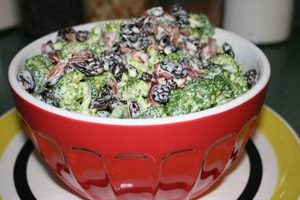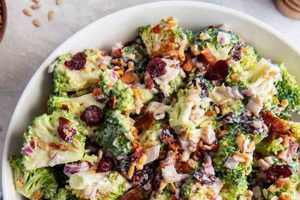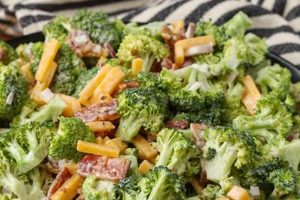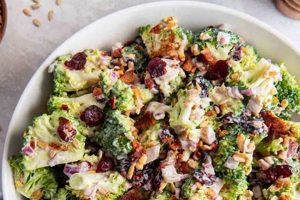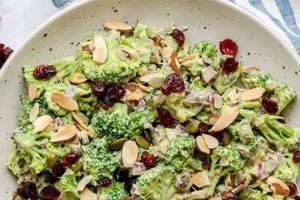This dish typically combines raw broccoli florets, dried cranberries, and a flavorful dressing, often incorporating mayonnaise, vinegar, and sweeteners. Variations may include other ingredients such as sunflower seeds, red onion, bacon, or almonds, offering a diverse range of textures and flavors. A simple version might involve a vinaigrette-based dressing while more complex iterations could feature creamy dressings and additional vegetables.
The combination of cruciferous vegetables and tart-sweet dried fruit offers a nutritional and flavorful experience. Broccoli provides vitamins, minerals, and fiber, while cranberries contribute antioxidants. The contrasting textures and flavors create a balanced profile, making it a popular side dish for various occasions, from potlucks to holiday meals. The adaptability of the dish allows for customization based on dietary preferences and seasonal availability of ingredients.
The following sections will explore variations on this culinary theme, offering detailed ingredient lists, step-by-step instructions, and tips for achieving optimal flavor and presentation. Nutritional information and suggestions for ingredient substitutions will also be provided.
Tips for a Successful Broccoli and Cranberry Salad
Achieving optimal flavor and texture requires attention to detail. The following tips offer guidance for creating a successful dish.
Tip 1: Blanch the Broccoli: Briefly blanching the broccoli florets in boiling water ensures a vibrant green color and a tender-crisp texture, preventing a raw, sulfurous taste. Cooling the broccoli immediately in ice water stops the cooking process.
Tip 2: Balance Sweetness and Tartness: The dressing should complement both the broccoli and cranberries. Balance the sweetness of dried cranberries and any added sugar with the tartness of vinegar or lemon juice.
Tip 3: Consider Texture: Toasted nuts or seeds, such as slivered almonds or sunflower seeds, add a satisfying crunch. Red onion offers a pungent bite, while crumbled bacon provides a savory contrast.
Tip 4: Dress Just Before Serving: To prevent the salad from becoming soggy, add the dressing shortly before serving. This maintains the crispness of the broccoli and other ingredients.
Tip 5: Choose Quality Ingredients: Fresh, high-quality broccoli and plump, flavorful dried cranberries are essential for a superior salad.
Tip 6: Customize to Preference: Adapt the recipe based on dietary needs and preferences. Consider using alternative sweeteners, such as honey or maple syrup, or substituting different nuts or seeds.
By following these guidelines, one can create a flavorful and visually appealing dish that complements a variety of meals.
This understanding of preparation techniques and ingredient selection facilitates a successful culinary experience.
1. Ingredients
Ingredient selection significantly influences the final flavor profile and nutritional value of a broccoli and cranberry salad. Careful consideration of each component contributes to a balanced and enjoyable culinary experience. The following facets highlight key ingredient categories and their respective roles.
- Base Vegetables:
Broccoli serves as the primary vegetable, providing a foundation of texture and flavor. Fresh, high-quality broccoli with firm florets and vibrant green color is crucial. Pre-cut florets offer convenience, while whole broccoli heads allow for customization of floret size. Blanching broccoli briefly enhances color and tenderness.
- Dried Fruit:
Dried cranberries contribute a sweet-tart element that complements the broccoli. Quality cranberries should be plump and moist, not overly dry or shriveled. Alternative dried fruits, such as cherries or apricots, can also be incorporated for flavor variations. The quantity of dried fruit influences the overall sweetness of the salad.
- Dressing:
The dressing binds the ingredients together and imparts significant flavor. Common choices include mayonnaise-based dressings, vinaigrettes, or yogurt-based dressings. The dressing should balance sweetness and acidity to complement both the broccoli and cranberries. Freshly prepared dressings generally offer superior flavor compared to pre-made options.
- Additional Components:
Nuts, seeds, and other vegetables add textural complexity and flavor nuances. Slivered almonds, sunflower seeds, or toasted pecans provide crunch. Red onion introduces a sharp bite, while crumbled bacon adds a savory element. These additions should complement the core flavors of the salad without overpowering them. Quantity should be carefully considered to maintain balance.
The interplay of these ingredient categories determines the overall success of the broccoli and cranberry salad. Harmonious combinations of flavors and textures result in a satisfying and nutritious dish.
2. Preparation
Proper preparation techniques are essential for a successful broccoli and cranberry salad. These techniques ensure optimal texture, flavor, and food safety. The following facets highlight key preparation steps.
- Broccoli Preparation:
Broccoli requires specific handling to maximize its contribution to the salad. Washing thoroughly removes any debris or pesticides. Cutting the broccoli into bite-sized florets ensures even cooking and easier consumption. Blanching the florets briefly in boiling water, followed by immediate immersion in ice water, preserves color and achieves a tender-crisp texture while mitigating any strong raw flavors. Overcooking results in a mushy texture and diminished nutritional value.
- Ingredient Combination:
The timing of ingredient combination impacts the overall quality of the salad. Adding the dressing too early can lead to a soggy salad, particularly if using mayonnaise-based dressings. Combining the dry ingredients broccoli, cranberries, nuts, seeds, etc. first allows for even distribution of the dressing when added just before serving. This maintains the desired textures and prevents the salad from becoming watery.
- Dressing Preparation:
Proper emulsification or blending of dressing ingredients is crucial for flavor and consistency. Whether using a whisk, blender, or food processor, ensuring that ingredients are thoroughly combined creates a smooth and evenly distributed dressing. Improperly emulsified dressings can separate and negatively impact the salad’s overall appeal. Tasting and adjusting seasonings before adding the dressing to the salad allows for flavor optimization.
- Storage:
Proper storage maintains the salad’s freshness and prevents bacterial growth. Storing the prepared salad, without dressing, in an airtight container in the refrigerator preserves its quality for several days. Adding the dressing immediately before serving maximizes freshness and prevents the salad from becoming soggy. Discarding any leftover salad that has been at room temperature for more than two hours minimizes food safety risks.
Careful attention to these preparation steps contributes significantly to the overall success of the broccoli and cranberry salad. Proper technique enhances both the sensory experience and the safety of the dish.
3. Flavor Balance
Flavor balance is paramount in a successful broccoli and cranberry salad recipe. The inherent flavors of the main componentsbroccoli, cranberries, and dressingmust harmonize to create a palatable and enjoyable dish. A well-balanced salad avoids extremes in sweetness, tartness, or savoriness, allowing the individual flavors to complement each other without one dominating the others.
- Sweetness and Tartness:
The natural sweetness of dried cranberries provides a counterpoint to the slightly bitter notes of raw broccoli. The dressing often incorporates a sweet element, such as sugar or honey, to enhance this contrast. However, excessive sweetness can mask the other flavors. Balancing this sweetness with acidity, typically from vinegar or lemon juice, is crucial. This interplay of sweet and tart creates a dynamic flavor profile that prevents the salad from being overly sweet or excessively sour.
- Creaminess and Acidity:
Mayonnaise-based dressings contribute a creamy texture and richness. However, relying solely on mayonnaise can result in a heavy, bland salad. Incorporating acidic ingredients, such as vinegar or lemon juice, into the dressing cuts through the richness of the mayonnaise, providing a refreshing contrast. This balance prevents the salad from becoming cloying and adds brightness to the overall flavor profile.
- Savory and Sweet Notes:
The addition of savory elements, such as toasted nuts, crumbled bacon, or red onion, further enhances the flavor complexity. These ingredients provide a counterpoint to the sweet and tart elements, creating a more well-rounded flavor profile. The savory notes also add textural interest, contributing to a more satisfying culinary experience.
- Influence of Seasonings:
Seasonings, such as salt, pepper, and herbs, play a critical role in flavor balance. Salt enhances the natural flavors of the ingredients, while pepper adds a subtle spice. Herbs, such as dill or chives, can introduce fresh, aromatic notes that complement the other flavors. The judicious use of seasonings elevates the overall flavor profile without overpowering the core ingredients.
Achieving optimal flavor balance in a broccoli and cranberry salad involves careful consideration of these interacting elements. A harmonious blend of sweet, tart, creamy, savory, and aromatic notes results in a salad that is both refreshing and satisfying. The interplay of these flavors elevates the dish beyond a simple combination of ingredients, creating a complex and enjoyable culinary experience.
4. Texture
Texture plays a crucial role in the overall appeal of a broccoli and cranberry salad recipe. A successful rendition offers a variety of textures that interact harmoniously, creating a more engaging sensory experience. The interplay of textures contributes significantly to the enjoyment of the dish, elevating it beyond a simple combination of flavors.
The inherent textures of the core ingredientsbroccoli and cranberriesprovide a foundational textural contrast. Broccoli, when properly prepared, offers a crisp-tender texture. Blanching achieves this ideal state, avoiding both excessive softness and undesirable rawness. Dried cranberries contribute a chewy texture, distinct from the broccoli’s crispness. This initial contrast establishes a foundation for further textural complexity.
Supplemental ingredients introduce additional textural layers. Common additions such as nuts and seeds provide a satisfying crunch. Toasted slivered almonds, sunflower seeds, or pepitas offer varying degrees of hardness and crispness, further diversifying the textural profile. Red onion, when thinly sliced, contributes a sharp, crisp bite, while crumbled bacon adds a contrasting chewy-crisp element. The careful selection and preparation of these supplemental ingredients allows for a nuanced and balanced textural experience.
The dressing, while primarily contributing to flavor, also influences texture. A creamy mayonnaise-based dressing adds a smooth, coating element, binding the ingredients and providing a textural counterpoint to the crunchier elements. A vinaigrette, on the other hand, offers a lighter, less coating texture, allowing the individual textures of the ingredients to remain more distinct. The choice of dressing should complement the desired overall textural profile.
5. Presentation
Presentation significantly influences the perceived appeal of a broccoli and cranberry salad recipe. While flavor and texture are paramount, visual appeal enhances the dining experience. Consideration of color, arrangement, and serving vessel contributes to a more enticing presentation. A well-presented salad entices consumption, even before the first bite.
Color contrast plays a vital role. The vibrant green of broccoli, the deep red of cranberries, and the potential inclusion of other colorful ingredients, such as red onion or yellow bell peppers, create visual interest. A monochromatic presentation lacks vibrancy and may appear less appetizing. Strategic placement of ingredients highlights these color contrasts. For instance, distributing cranberries evenly throughout the salad prevents clumping and ensures visual balance. Similarly, incorporating a variety of texturescrunchy nuts, smooth broccoli florets, and chewy cranberriesenhances visual appeal alongside textural complexity.
The choice of serving vessel further impacts presentation. A clear glass bowl showcases the vibrant colors and textures of the salad. A shallow platter allows for a more artistic arrangement, while individual portions in small bowls offer a refined presentation for more formal occasions. Garnishing with fresh herbs, such as dill or parsley, adds a final touch of elegance and reinforces the freshness of the ingredients. Thoughtful presentation elevates the perceived value of the dish, transforming a simple salad into a visually appealing culinary creation. This attention to detail communicates care and enhances the overall dining experience.
6. Nutritional Value
Nutritional value represents a significant aspect of a broccoli and cranberry salad recipe. This dish offers a combination of vitamins, minerals, antioxidants, and fiber, contributing to a healthy diet. Broccoli, a cruciferous vegetable, provides vitamins C and K, folate, and potassium. Cranberries are a source of antioxidants, particularly proanthocyanidins, associated with urinary tract health. The inclusion of other ingredients, such as nuts and seeds, further enhances the nutritional profile, adding healthy fats, protein, and additional vitamins and minerals. For example, almonds contribute vitamin E and magnesium, while sunflower seeds provide selenium and vitamin B6. The specific nutritional content varies depending on the chosen ingredients and dressing.
Understanding the nutritional composition allows for informed choices regarding ingredient selection and portion sizes. Individuals with specific dietary needs can adapt the recipe accordingly. For instance, those seeking to reduce added sugar can opt for a vinaigrette-based dressing or use a sugar substitute. Individuals requiring higher protein intake can incorporate more nuts, seeds, or even grilled chicken or fish. Recognizing the nutritional contribution of each ingredient empowers individuals to tailor the recipe to meet their specific health goals. For example, incorporating a variety of colorful vegetables extends the range of micronutrients consumed. The nutritional density of this salad makes it a valuable component of a balanced diet, contributing to overall well-being.
The nutritional value of a broccoli and cranberry salad extends beyond its individual components. The combination of ingredients offers synergistic benefits. For instance, the vitamin C in broccoli enhances the absorption of non-heme iron from plant-based sources, such as nuts and seeds. Furthermore, the fiber content from both broccoli and cranberries promotes digestive health and contributes to satiety, aiding in weight management. Recognizing the combined nutritional impact of the ingredients highlights the importance of this salad as a healthful dietary choice. While variations exist, the fundamental nutritional benefits remain consistent, making it a versatile and nutritious option for various dietary patterns.
Frequently Asked Questions
This section addresses common inquiries regarding broccoli and cranberry salad recipes, providing concise and informative responses.
Question 1: Can frozen broccoli be used?
While fresh broccoli is preferred for optimal texture and flavor, frozen broccoli can be substituted. Ensure it is thoroughly thawed and drained before incorporating it into the salad to prevent excess moisture.
Question 2: How long can the salad be stored?
Prepared salad, without dressing, can be stored in an airtight container in the refrigerator for up to three days. Adding the dressing immediately before serving is recommended to maintain optimal texture and prevent sogginess.
Question 3: What dressings can be used besides mayonnaise-based ones?
Vinaigrettes, particularly those with apple cider vinegar or balsamic vinegar, offer a lighter alternative to mayonnaise-based dressings. Greek yogurt-based dressings provide a creamy texture with lower fat content.
Question 4: Can other dried fruits be substituted for cranberries?
Dried cherries, apricots, or golden raisins can be substituted for cranberries, offering variations in flavor and sweetness. Consider the sweetness and tartness of the chosen dried fruit when adjusting the dressing’s flavor profile.
Question 5: How can the salad’s nutritional value be maximized?
Incorporating a variety of nuts and seeds, such as almonds, walnuts, sunflower seeds, or pumpkin seeds, increases the salad’s healthy fat, protein, and micronutrient content. Adding other vegetables, like shredded carrots or chopped bell peppers, further enhances the nutritional density.
Question 6: Can this salad be served as a main dish?
While typically served as a side dish, the salad can be adapted to a main course by adding protein sources such as grilled chicken, fish, or tofu. Adjusting the portion size and incorporating more substantial ingredients can create a more filling and complete meal.
Addressing these common questions clarifies potential uncertainties and facilitates a deeper understanding of broccoli and cranberry salad preparation and variations.
The following section will offer a selection of specific recipes with varying ingredient combinations and flavor profiles.
Broccoli and Cranberry Salad Recipe
This exploration of broccoli and cranberry salad recipes has highlighted the multifaceted nature of this seemingly simple dish. From ingredient selection and preparation techniques to flavor balance, texture, presentation, and nutritional value, each aspect contributes significantly to the overall culinary experience. The interplay of sweet and tart flavors, combined with a variety of textures, creates a balanced and satisfying salad. Understanding the nutritional benefits further enhances appreciation for this dish as a healthy and versatile dietary choice.
The adaptability of this salad allows for endless variations, catering to individual preferences and dietary needs. Experimentation with different ingredients, dressings, and presentation styles encourages culinary creativity and personalized flavor experiences. This exploration serves as a foundation for continued exploration of this versatile and nutritious culinary creation.


